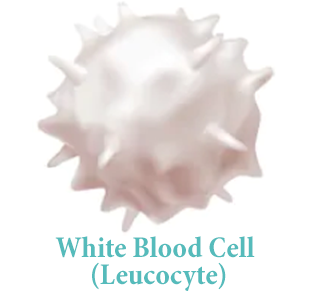Lab Test Results Interpretation Online
Complete Blood Count (CBC) Urinalysis (UA) Comprehensive Metabolic Panel (CMP) Thyroid Function Tests (TFTs) Fasting Blood Glucose TestWhite Blood Cell Count (WBCs, Leukocytes)
Also known as: WBC, WBC Count, Leukocyte Count, White Count
What is WBC?
Leukocytes are colorless blood cells that have nuclei. They are produced in the bone marrow and lymph nodes. Their main function is protecting the body against microbes, bacteria, viruses, and foreign cells. White blood cells produce antibodies, are engaged in immune reactions, and bind and destroy harmful agents.

Types of WBCs
Interpret now "Comprehensive Metabolic Panel (CMP)"
Interpret now "Urinalysis (UA)"
All white blood cells are divided into five types: neutrophils, eosinophils, basophils, lymphocytes, and monocytes, and each has its own function. The percentage of one of the five types of leukocytes falls or rises due to a decrease or increase in the other types of leukocytes. For instance, a white blood count may show the type of leukocytes due to which an increase in total leukocytes occurs. A white blood count may be indicative of complications and pathological processes, as well as help forecast the clinical outcome.
White blood cells are classified into two main groups: granulocytes (have granules in their cell cytoplasm), and agranulocytes, or nongranulocytes (do not have granules). Agranulocytes include monocytes and lymphocytes. Granulocytes, in turn, are divided into neutrophils, basophils, and eosinophils.
WBC Differential Count
A blood differential test may be a part of a complete blood count (CBC).
White blood cells can be counted manually or with automated counters. A drop of blood is thinly spread over a clear glass slide and the number of each white blood cell type is counted.
Differential white blood cells (leukocytes) count gives information about the relative percentage of each type of white blood cell.
It is important to understand the difference between relative and absolute changes in different types of white blood cells (leukocytes) in the blood. A relative change in white blood cell count means that the percentage of certain types of leukocytes is higher or lower than normal. WBC absolute values are also calculated, meaning how many cells of each type of leukocytes are contained in one liter of blood (or thousands/uL).
The absolute value of each type of WBC can be calculated using the following formula:
А x WBC / 100
- А (%) – a certain type of WBC as compared with the other leukocytes in %,
- WBC (109/L) – total white blood cell count.
Units of Measure
The number of white blood cells can be expressed in international units:
- 109 cells/liter
- G/L – Giga per Liter. (Giga = 1 billion)
Conventional units:
- thousand per cubic millimeter (1000/mm3, 103/mm3)
- thousand per microliter (1000/µL, 103/µL)
- K/mm3 (thousand cells per cubic millimeter)
- K/µL (thousand cells per microliter)
- cells/mm3
- cells/µL
Conversion factors:
Cubic millimeter (mm3) = microliter (mcL, µL)109 cells/Liter = G/L = 103/mm3 = 103/µL = K/mm3 = K/µLNormal Range
White blood cells together with platelets make up only 1% of all blood cells in healthy people.
The normal range of white blood cells in adults is 4 to 11 x 109 cells/L.Reference ranges for WBC count:
- Neutrophils: 55-70% (2.5-8 x 109 cells/L)
- Lymphocytes: 20-40% (1-4 x 109 cells/L)
- Monocytes: 2-8% (0.1-0.7 x 109 cells/L)
- Eosinophils: 1-4% (0.05-0.5 x 109 cells/L)
- Basophils: 0.5-1% (0.025-0.1 x 109 cells/L)
Normal ranges can vary between different laboratories.
Infants usually have higher WBC count than adults, which gradually decline as they age.
According to the Mayo Clinic, the normal levels of white blood cells in a child are as follows:
| White Blood Cells (WBC) | Age | Reference Interval (103 /µL) |
| Birth | 9-30 | |
| 1-3 days | 9-38 | |
| 4-7 days | 5-21 | |
| 7-14 days | 5-20 | |
| 15-60 days | 5-20 | |
| 2-5 months | 5.5-18 | |
| 6 months – 1 year | 6-17.5 | |
| 1-3 years | 6-17 | |
| 3-5 years | 5.5-15.5 | |
| 6-10 years | 4.5-14.5 | |
| 10-15 years | 4.5-13.5 | |
| 15-20 years | 4.5.12.5 | |
High White Blood Cell Count
Leukocytosis (elevated levels of white blood cells) indicates an inflammatory process or acute infections – mostly bacterial ones. A high white blood cell count is not always an indicator of some disease – white blood cells respond to various changes in the body. For instance, stress, pregnancy or exercise may cause an increase in white blood cell counts.
During pregnancy, a slightly elevated white blood cell count is a physiological response to the stimulation of blood formation and requires no treatment.
Low White Blood Cell Count
A low white blood cell count (leukopenia) is an indicator of a weakened immune system. Leukopenia may be caused by some viral infections, such as flu, chickenpox, and German measles, or medications, such as analgesics or anticonvulsant drugs.
+ Sources
- The Editors of Encyclopaedia Britannica. (2018, Dec 13). White blood cell. Retrieved from
https://www.britannica.com/science/white-blood-cell - Rachel Nall. (2020, Jan 9). What to know about white blood cells. Retrieved from
https://www.medicalnewstoday.com/articles/327446.php#types-and-function - Choladda Vejabhuti Curry. (2019, Nov 20). Differential Blood Count. Retrieved from
https://emedicine.medscape.com/article/2085133-overview - Abbassi-Ghanavati M, Greer LG, Cunningham FG. Pregnancy and laboratory studies: a reference table for clinicians [published correction appears in Obstet Gynecol. 2010 Feb;115(2 Pt 1):387]. Obstet Gynecol. 2009;114(6):1326–1331. doi:10.1097/AOG.0b013e3181c2bde8
https://pubmed.ncbi.nlm.nih.gov/19935037-pregnancy-and-laboratory-studies-a-reference-table-for-clinicians/ - Chandra S, Tripathi AK, Mishra S, Amzarul M, Vaish AK. Physiological changes in hematological parameters during pregnancy. Indian J Hematol Blood Transfus. 2012;28(3):144–146. doi:10.1007/s12288-012-0175-6
https://www.ncbi.nlm.nih.gov/pmc/articles/PMC3422383/#Sec2title